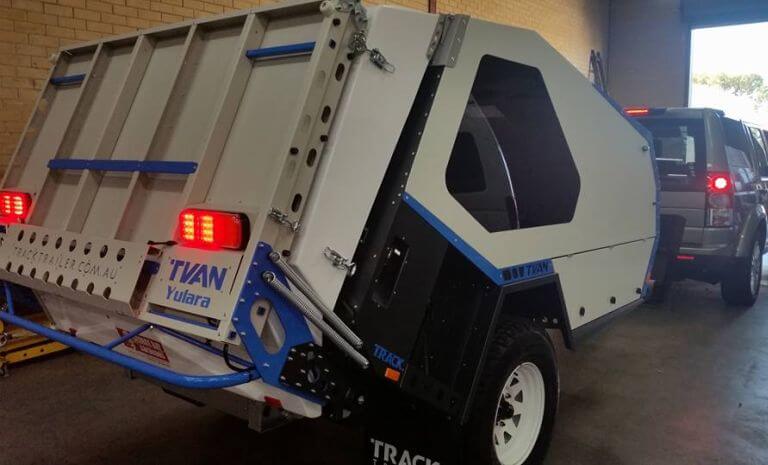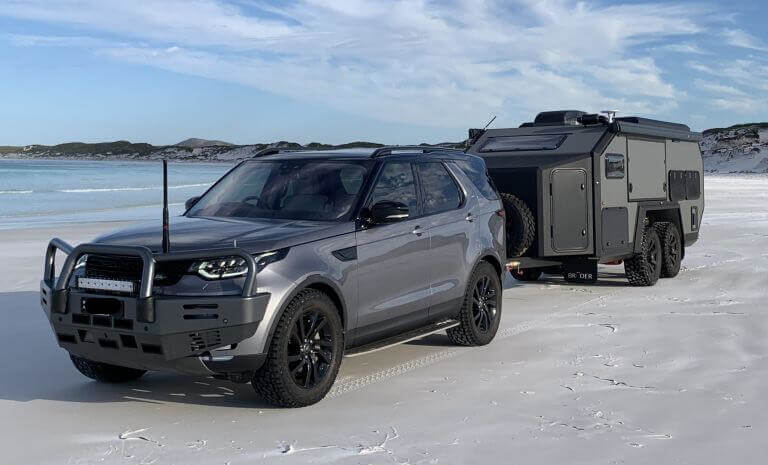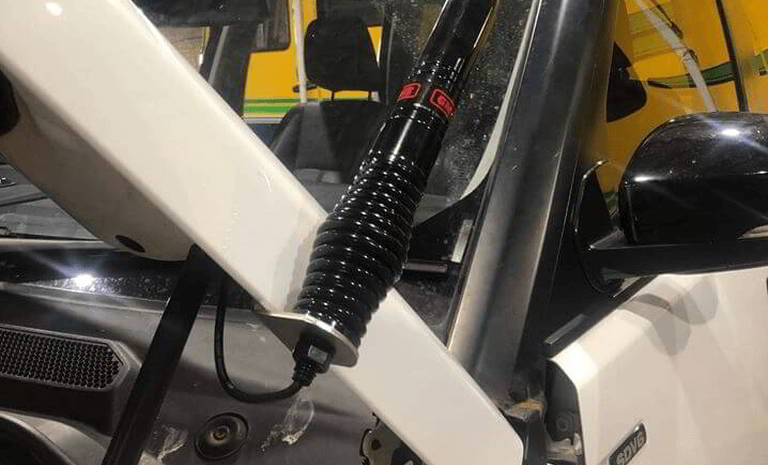For most travellers, a perfect holiday starts with packing a caravan or trailer full of stuff, attaching it to your vehicle, and hitting the road searching for great places to camp and surf. It sure sounds like fun, and you’ve got all the right ingredients for a fantastic time. But people tend to forget that towing a caravan or trailer comes with a significant danger if proper caravan sway control is not accounted for. Camper trailer or caravan sway is not only very unpleasant to experience, but is also extremely dangerous and can cause a crash and injuries.
So, it’s very important to understand what caravan sway is, how to avoid it, and what products are available to control it. In this article we will teach you the basics of towing safety and how to properly manage caravan sway.
What is Caravan Sway?
During towing, the trailer or caravan can suddenly start to move from one side of the road to the other. If the driver is not experienced enough to keep the vehicle stable, or the swaying is extensive and uncontrollable, the snaking can cause the trailer to flip over and often flip the towing vehicle as well. The sway is the most dangerous thing and usually happens on highways at cruising speeds.
Source: youtube.com
There are numerous reasons why this sway occurs, but the most common are a tyre puncture, uneven weight distribution, or a gust of sudden side winds. The swaying might happen when there are problems with the suspension, or if you are driving too fast downhill, and your caravan or trailer wants to overtake you. Passing a large road train going the opposite way can produce a significant gust that unbalances what you are towing as well.
Whatever the reason, losing the control of the trailer can result in detaching the trailer or even the flipping over the tow vehicle and the trailer at the same time. If the tow vehicle is a lot larger than the trailer or caravan, the impact of the sway is usually smaller. But if you are towing a big load behind you, then even the slightest sway can be very dangerous.
Fundamentals of Sway Control
To keep the danger of trailer or caravan swaying to the minimum, it’s important to understand the physics involved. The load position lengthways along the trailer or caravan can significantly impact the risk of sway. The safest position for a load is achieved by placing the heavy items as close to the axles as possible. Particularly avoid placing an unbalanced load on the end of the trailer, since this position has the greatest ability to act as a lever and build sway momentum.
The trailer’s load should also be equally distributed in a horizontal plane across the axle as well where possible.
Source: youtube.com
Also, it is very important to ensure you have the right brakes fitted and that your tyres are capable of carrying the load and inflated according to manufacturers’ specifications. Always check the tyre pressure recommendations and properly inflate your tyres.
It’s also important to bear in mind the max towing weight of the vehicle and the max load weight for the trailer or caravan itself. Exceeding these limits will put you unnecessarily at risk of the effects of caravan sway.

When towing a heavy load, always try to drive defensively, slow down, and pay attention to road conditions, strong winds and drive under the limit. Of course, it goes without saying that sudden changes of direction, sharp turning or erratically overtaking on the highway are extremely dangerous and can cause sway and loss of control almost immediately.
How to stop the caravan sway?
No matter how careful you are or how well you prepared your rig, there is always swaying danger. If you experience unpleasant swinging of your trailer or caravan and you see it moving from side to side in your rear-view mirror, the first thing is to keep calm and don’t overreact. Sudden and erratic movements will only make things worse. Here is what you need to do:
- Try to steer as little as possible. It’s generally best to hold your vehicle’s position and go straight so that the sway stops. If you swerve or make quick movements, it’s only likely to make the problem worse.
- Take your foot off the accelerator but do not brake suddenly. Reducing acceleration will in turn reduce the trailer or caravan oscillation magnitude.
- If you want to stop, first be sure that the swaying has stopped and then press the brakes gently or use the electronic brake controller to apply the caravan brakes.
- In Australia, all caravans with a gross weight of over 2000 kg are required to have an electronic brake controller by law.
Trailer Sway Control devices and Caravan Sway Control Products
Fortunately, there are dozens of useful sway control systems that drivers can install on their rigs in order to prevent swaying and have a safe trip. The list of products is long, but we recommend starting with the REDARC Tow-Pro Elite electric brake controller.
Tow-Pro Elite

The Tow-Pro Elite is an electric brake controller specifically designed for trailers and caravans. Electronic brake controllers are mandatory for all caravans over two tones of gross weight. The Tow-Pro Elite is engineered to allow driver intervention to apply the brakes independently of the tow vehicle and “calm down” the trailer instantly. Using modern technology and precise engineering, the Tow-Pro Elite provides the drivers with peace of mind.
When a sudden gust of wind from a passing lorry tries to unbalance your load, simply hit the control knob on the Tow-Pro Elite to temporarily apply the caravan brakes and bring it back into alignment with the tow vehicle.
The advantage of the Tow-Pro Elite over its competitors is its construction: the Tow-Pro Elite has a three-axis accelerometer, and it can be mounted in any orientation and still be able to precisely determine the amount of braking needed. Besides that, you can adjust the amount of braking force by the dash mounted controller unit according to the trailer or caravan’s weight and stopping force required.
This model has two main modes of operation (proportional or user-controlled), which makes it ideal for providing stability control for all road conditions as well as for off-road use. For advanced users, especially people that often drive in off-road conditions, user-controlled mode is perfect since it adjusts to the problematic conditions (mud, snow, sand) and gives you full manual control over the braking level required for your particular trailer or caravan.
To see the REDARC Tow-Pro Elite in action whilst towing, click here.
Stabilizers, Equalizers, and Weight Distribution Hitches
Next on the list of caravan sway control products are anti-sway stabilisers, equalisers, and weight distribution hitches. The stabiliser bars for caravans are used to prevent the caravan or trailer from tipping over. However, the weight distribution hitches are used to level the caravan or trailer when attached to the vehicle. The integral part of the weight distribution hitch is an adjustable tow ball height. This way, the caravan can be levelled with the tow vehicle’s tow hitch, and you can achieve better tow ball weight balance.
Anti Sway Bars
Anti-sway bars for caravans are very common and very helpful devices for all motorists who often tow trailers. The working principle is relatively simple; the anti-sway bars are mounted on the caravan hitch near the tongue of the trailer and extend to the trailer brakes. When you experience the sway, the bars help break and “calm down” the caravan before the swaying gets extensive and forces you to lose control. Depending on the tow vehicle, the anti-sway bars need to be mounted and adjusted according to the size and weight of the caravan or trailer. Only then can you expect full performance and protection from this device.
There are two basic types of anti-sway bars for caravans:
- independent anti-sway bars that bolt on to the trailer frame. These must be disconnected when reversing.
- dependent anti-sway bars, which are a bit more complicated and rely on force created by the included spring bars. Since the dependent anti-sway bars apply friction to both sides of the caravan frame, it means it can stop swaying as soon as it occurs. Dependent anti-sway bars do not need to be disconnected when reversing.
Both designs of anti-sway bars are great for reducing most of the caravan sway in normal driving conditions. However, they can be problematic in extreme conditions when the force of the sway is too strong. If that occurs, the trailer can still cause the tow vehicle to flip over.
Friction Sway Control Bars
Besides the standard anti-sway bars for caravans, there are also friction bars that use the same idea but different execution. The anti-sway bars are mounted on A-frame and have friction pads that work like brake pads in case you experience caravan sway. You can adjust the amount of braking or friction you require from this system. However, these are not recommended for use if you already have mechanical override brakes or electric brake control. The friction sway bars are somewhat more affordable than the classic anti-sway bar setup but they are better suited for only smaller trailers or caravans.
If you’re unsure about the best way to limit caravan or trailer sway, be sure to contact us and one of our friendly experts will be happy to help.
Safe travels!




